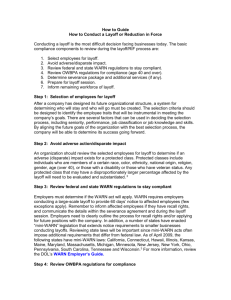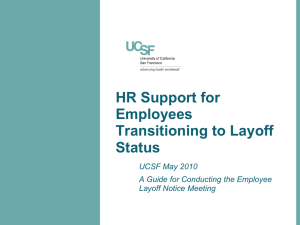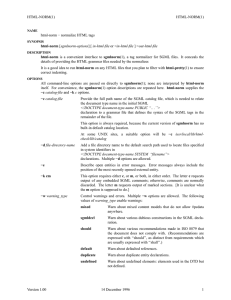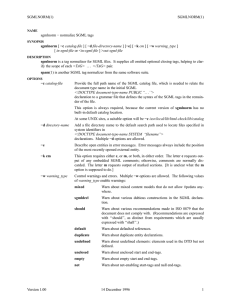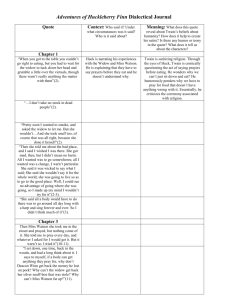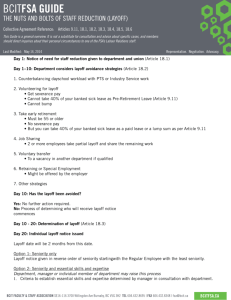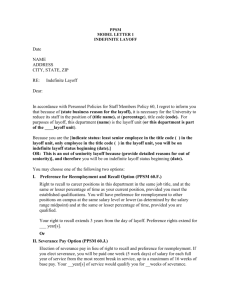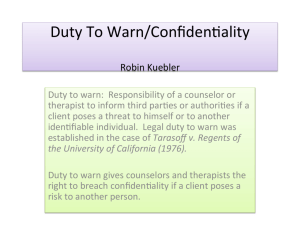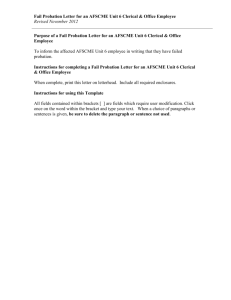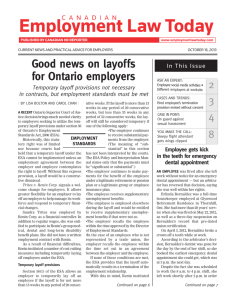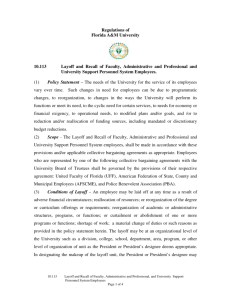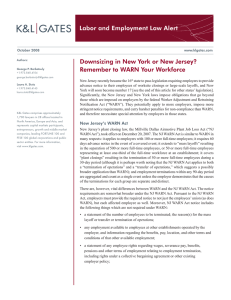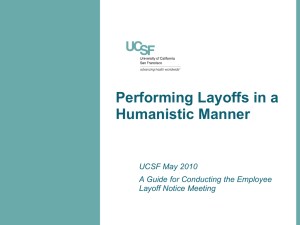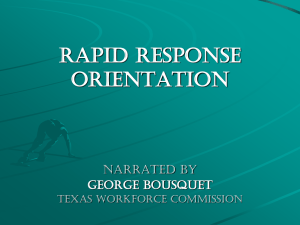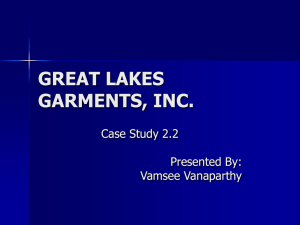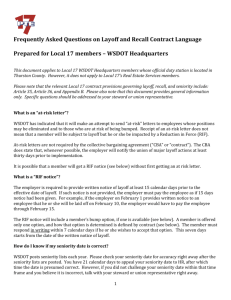Myers-Jeff Webinar
advertisement
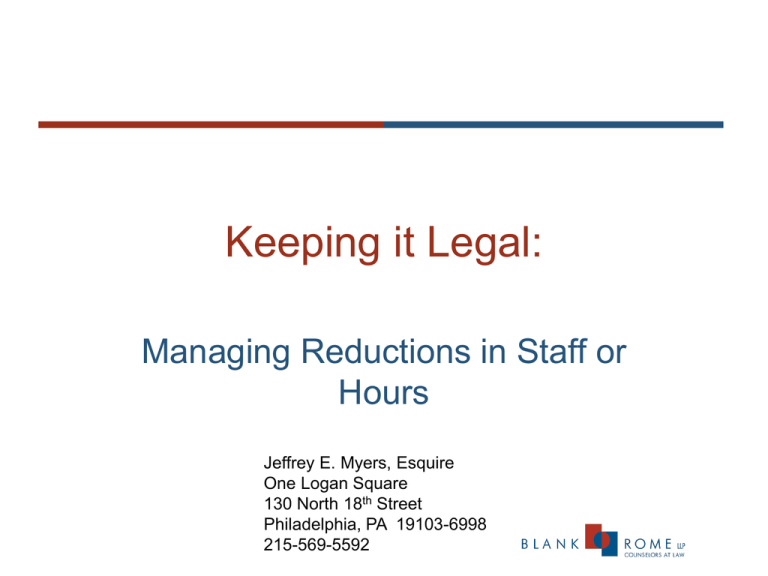
Keeping it Legal: Managing Reductions in Staff or Hours Jeffrey E. Myers, Esquire One Logan Square 130 North 18th Street Philadelphia, PA 19103-6998 215-569-5592 Creating a Plan For Your Reduction in Force • • • • • • • Identify the Goals/Needs Design New Structure to Meet Goals Identify Areas to be Affected Consider Different Downsizing Methods Adopt Objective Selection Criteria Identify Employees to be Affected Perform Disparate Impact Analysis 2 RIF Alternatives • • • • • • • Attrition Reshaping Early Retirement Incentives Voluntary Layoff Contracting In Furloughs ATB Pay Reduction 3 Legitimate Incentives • Flat Dollar • Service Based • Incentives Based on a Percentage of Salary • Increases in Pension Benefits 4 Alternatives To Reductions In Force: Wage & Hour Considerations • Potential Impact On Exempt Status of Salaried Workforce • Recent U.S. Department of Labor Opinion Letters – Permanent changes to salary and workweek permitted – Short-term changes may violate salary basis requirement – Mandatory Time Off okay if: • Week or longer and employee performs NO work • Employee receives PTO for shorter periods – Voluntary Time Off okay if: • Full day or longer • Truly voluntary 5 Volunteers • FLSA defines employment broadly (i.e., “to suffer or permit to work”) • Individuals who volunteer or donate their services for the following are generally not considered employees: – Public service – Religious or humanitarian objectives • Volunteers typically are part-time • Volunteers generally act without contemplation of pay • Employees may not volunteer services to for-profit private sector employers 6 EEO Concerns Disparate Treatment • Prima facie case – Member of protected class – Qualified – Adverse action – Others outside protected class treated differently • Employer’s burden: adverse action taken for legitimate, non-discriminatory reasons 7 EEO Concerns Disparate Impact • Prima facie case – Neutral selection criteria, BUT – Disproportionate number of employees from protected class affected • Employer’s burden: selection criteria are job related and consistent with business necessity; no less burdensome option 8 Questions To Ask • Is there a clear and legitimate business reason for the RIF? • Are there objective criteria for selecting employees? • Were the criteria applied consistently? • Are actions consistent with all applicable policies? • Were terminated employees soon replaced? 9 Questions To Ask • If performance is a factor, how objective are evaluations/forced rankings? • Are early retirement incentives legitimate? • Any statistical anomalies? • Were all contract provisions complied with? • How were employees on leave treated? 10 Determining When a RIF Triggers Application of the WARN Act • Employers: – 100 or more employees – Excluding those who worked less than 6 of the past 12 months OR less than 20 hours/week on average • Employees: – Hourly & salaried – Managerial & Supervisory – NOT business partners 11 WARN Act • Qualifying Events – “PERMANENT” Plant Closure (Site or Facility) • 50 or more employees affected in any 30 day period – Mass Layoff • 500 or 50 &1/3 – Aggregated Layoffs • Employment Loss Defined – Termination – Layoff for more than 6 months – Reduction in Hours (6/50 rule) 12 Consideration of State and Local Office Closing Laws • More and more state and local governments are passing plant closing legislation that varies from federal WARN Act: – New York, New Jersey – Philadelphia Ordinance • • • • • Apply to smaller employers Different notice periods Increased Severance Pay obligations in lieu of notice Different definitions of triggering events Different damage provisions and penalties 13 Examples of States With Their Own “WARN” • • • • • California Hawaii Illinois Maryland Massachusetts • • • • • New Hampshire New Jersey New York Tennessee Wisconsin 14 Designing a Separation Package • The package must include: – Earned Compensation – Vacation – Other Earned Benefits • The package may also include a separation agreement including severance pay and a release of claims • Outplacement/U.C. Assistance 15 Designing a Separation Package OWBPA Requirements • Group terminations (more than one) • 45 day consideration period/7 day revocation period • Disclosure Statements with Separation Documents – – – – – Identify the decisional unit Eligibility factors Time limits Job titles and ages of all employees in the unit Identification of who was selected/not selected for termination 16 Other Release Pointers • • • • • • Plain language Knowing/voluntary Real consideration Right to counsel Care in integration State affirmative obligations of employees 17 Communications Strategy • The Displaced (Notice) – When – By Whom – Content • Public • Customers • The Survivors 18 Safety Concerns • Take necessary security and safety measures before something happens • Warning Signs for potential workplace violence: – Inflexible-difficulty coping with change – Makes threats or intimidating comments – Displays hopelessness or paranoia – Takes criticism poorly 19 Steps Employers Should Take to Secure Intellectual Property • Ensure that computer passwords are changed prior to termination or layoff • Ensure internal security protocols actually are being pursued • On the eve of a layoff, make sure large amounts of documents are not being copied or downloaded • Actual security • Review the legal rights in states in which the employer is taking personnel actions 20 FOCUS Finally, F air O bjective C onsistent U nified S ympathetic 21 Implementation Contract Review • Review Collective Bargaining Agreements – Layoff Clause – Bumping – Notice – Pension 22 Use following slides only if required 23 Bargaining Issues • Decisional – Required only if motivated by labor costs such as wages and benefits • Effects – Timing – Payment of Severance – Continuation of Health Coverage 24 WARN Act Who is Entitled to Notice? • • • • Union Individual Employees Chief Elected Local Government Official State Dislocated Worker Office 25 WARN Act: How Much Notice? • Basic -- 60 Days or • As Much as Practicable (Not Zero) • Natural Disaster • Unforeseen Business Circumstance • Faltering Company 26 WARN Act Form and Content of Notice • • • • • Identify Site Contact Person Permanent/Temporary Dates of Terminations Affected Employees (Names, Classifications and Numbers) • Bumping Rights • Union Information 27 WARN Act Penalties • Sixty Days of Pay (Calendar v. Working) • Sixty Days of Benefits (Includes Gratuities) • Civil Penalty -- $500 Per Day 28
